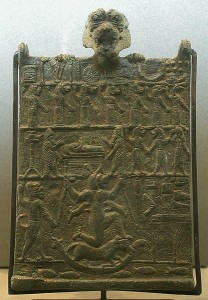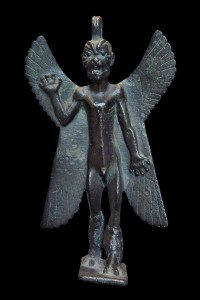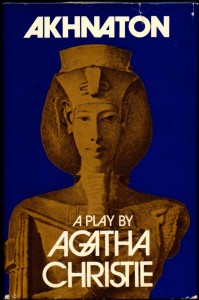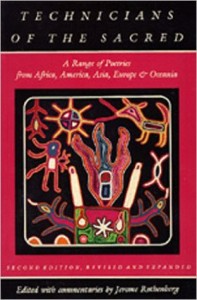Today, Agatha Christie plays Final Fantasy over the ruins of Babylon, watched by some bored Bedouin and an arthritic camel. And many apologies to lurchers lovers – our little donkeys will return next week. But for now it’s the final episode of Ghoul Trek, boldly going where most sites are smart enough not to go, and the last part of our scholarly investigation into the origins of the 20th century literary creature, the ghoul. If, of course, instead of ‘scholarly investigation’ you’ll settle for three rambling articles nailed together under the influence of dog hair.

Many years ago, when we were young and danced merrily o’er buttercup meadows, we bought a great big book, The Rattle Bag, edited by Seamus Heaney and Ted Hughes. It’s basically 500 pages containing most of the poetry you need for an interesting life, including hunter’s songs, anonymous lines, historical verse and cool poets. And it has a fragment called The Seven. Poetry sucks, you say – where are all the creepy monsters? Well…
In the terrible depths, the dark houses
They swell, they grow tall
They are neither female nor male
They are a silence heavy with seastorms.
The whole piece is a disturbing evocation of something unholy and dark, ‘the faces of evil’. What are these creatures? They are gallu, our ultimate goal. Not as in we want to meet them, more as in ‘Where did the concept of the ghoul come from in the first place?’
No-one wants much of a recap on the last two articles, do they? Let’s just say that H P Lovecraft and other weird horror writers messed with 17th and 18th century Gothic muddles, Islamic tales varied, Bedouins crossed a lot of sand and found lumps of Mesopotamian legend in the ruins. It’s our formula of the month:
ghoul = ghul = gallu
In Sumerian, Babylonian and Assyrian mythology, the gallus or gallu demons were dark and wicked beings from the underworld. Sometimes they seem to have had the attributes of gods, sometimes they were seen as the offspring of devils and human women. They were unusual in their ability to travel between the normal world and underworld, and could carry people off into eternal darkness.
In Babylonian mythology they could be held back or appeased by sacrificing animals to them, as they were known to prey on herds as well as people. The gallu was generally humanoid in appearance, occasionally animal-headed (often that of a bull), and caused nightmares, making people flee in terror and so on.
Importantly for our trail, the gallu was known to drink blood and eat human flesh. So it seems that these gallu demons are the original source of the ghul, both in etymology and some of their habits. As suggested, the most likely reason for this is that the tribes of Arabia and surrounding lands had trade links with Mesopotamia (present-day Iraq and its neighbours). Through these links, they absorbed and spread the idea of the gallu, which became the ghul.

R Campbell Thompson, the Edwardian archaeologist who we’ve met here before, translated many of the original cuneiform records in the late 19th and early 20th centuries. To add to your trivia banks, we feel it only fair to mention that Agatha Christie, the detective writer, knew him.
In 1931 she and her husband (who was also an archaeologist) were invited to the excavation site at Nineveh. She dedicated her story Lord Edgware Dies to “Dr. and Mrs. Campbell Thompson”. In 1937 she wrote the play Akhnaton, which fascinated us when young.
Anyway, we were talking about Campbell Thompson. He wrote:
There are certain spirits described as “the Seven” around whom a great many poems were composed and welded into the incantations and spells. The best known is the Invocation against the Seven: —
Seven are they! Seven are they!
In the Ocean Deep seven are they!
Battening in Heaven seven are they,
Bred In the depths of Ocean.
Nor male nor female are they,
But are as the roaming windblast,
No wife have they, no son can they beget;
Knowing neither mercy nor pity,
They hearken not to prayer or supplication.
They are as horses reared among the hills…
Of these seven [the first] is the South Wind.
The second Is a dragon with mouth agape
That none can [withstand];
The third is a grim leopard
That carrieth off children…
The fourth is a terrible serpent…
The fifth is a furious beast [?]
After which no restraint…
The sixth is a rampant […]
Which against god and king.
The seventh is an evil windstorm…
These seven are the Messengers of Anu, the king:
Bearing gloom from city to city,
Tempests that furiously scour the heavens,
Dense clouds that over the sky bring gloom,
Rushing windgusts, casting darkness o’er the brightest day,
Forcing their way with baneful windstorms.
Mighty destroyers, the deluge of the Storm-God,
Stalking at the right hand of the Storm-God.
The Devils and Evil Spirits of Babylonia (1903)

You”ll see the similarities in the above to the Rattlebag version, which was apparently freely translated by Jerome K Rothenberg in the sixties. His Technicians of the Sacred collection (1968) was described as presenting:
‘primitive’ and ancient poetries as the incantations they are, loaded with power and very full of the magic that invests all good poetry. The treatment is fascinating…the commentaries are a gold mine of responses to the material by a strong poet (the editor), and his selection of analogous writings from a broad range of contemporary poets.
Can we provide any other evidence? For more on the gallu themselves, we turn to Morris Jastrow Jr and his book The Religion of Babylonia and Assyria (1893)
The demons were of various kinds and of various grades of power. The names of many of them, as utukku, shedu, alu, gallu, point to ‘strength’ and ‘greatness’ as their main attribute; other names, as lilu, ‘night-spirit,’ and the feminine form lilitu, are indicative of the moment chosen by them for their work; while again, names like ekimmu, the ‘seizer,’ akhkhazu, the ‘capturer,’ rabisu, ‘the one that lies in wait,’ labartu, ‘the oppressor,’ and labasu, ‘the overthrower,’ show the aim that the demons have in view. Putting these names together, we may form a general idea of the conceptions connected with the demons.

They lurk in hidden or remote places, in graves, in the shadow of ruins, on the tops of mountains, in the wilderness. Their favorite time of activity is at dead of night. They glide noiselessly like serpents, entering houses through holes and crevices. They are powerful, but their power is directed solely towards evil. They take firm hold of their victims and torture them mercilessly.
And there you have our ghul from last time, lurking in ‘hidden or remote places, in graves, in the shadow of ruins, on the tops of mountains, in the wilderness.’ We rest our case.
As an additional bit of evidence that these ideas survive far longer than you’d expect, even if they mutate a little, we’ll add a bit more of R Campbell Thompson:
But a still more striking evidence of the conservatism of Eastern tradition is shown in a Syriac charm which is worth quoting in full.
Seven accursed brothers, accursed sons!
destructive ones, sons of men of destruction!
Why do you creep along on your knees and move upon your hands?’
And they replied, ‘We go on our hands,
so that we may eat flesh, and we crawl along
upon our hands, so that we may drink blood.’
As soon as I saw it, I prevented them from devouring,
and I cursed and bound them in the name of the
Father, the Son, and the Holy Ghost, saying,
‘May you not proceed on your way, nor finish your
journey, and may God break your teeth, and cut
the veins of your neck, and the sinews thereof, that
you approach not the sheep nor the oxen of the
person who carries [sc. these writs]! I bind you
in the name of Gabriel and Michael. I bind you
by that angel who judged the woman that combed
(the hair of) her head on the eve of Holy Sunday.
May they vanish as smoke from before the wind
for ever and ever, Amen!’
If you like to go Biblical, we add this from Luke 11:24-26:
When the unclean spirit is gone out of a man, he walketh through dry places, seeking rest; and finding none, he saith, I will return unto my house whence I came out. And when he cometh, he findeth it swept and garnished. Then goeth he, and taketh to him seven other spirits more wicked than himself; and they enter in, and dwell there: and the last state of that man is worse than the first.
And if you thought that video games weren’t educational, the most contemporary use of gallu we could find was in the game Final Fantasy XI, where the gallu are fearsome demonic beings best not met. Especially not with their special abilities of Bolt of Perdition and Crippling Rime. Fancy that. The Sumerians would have been excited to get their hands on that one.
This weekend – it’s H P Lovecraft time again. Not content with dissecting his ghouls, we have a triffid interview with Lynne Jamneck, writer and editor of the recent release Dreams from the Witch House, coverage of the brand-new Mammoth Book of Cthulhu and some carefully chosen thoughts on sex with shoggoths. Come back in a couple of days and wallow in Mythosian badness…



